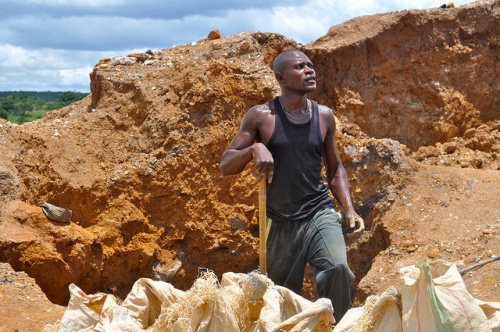BOGOR, Indonesia (16 July 2012)_Seen from the sky, a mining pit might look like ‘a small hole in the canopy’—visually a smaller footprint than the effect of other primary commodity production processes – such as plantation agriculture, CIFOR researcher Louis Putzel concedes. However, in terms of total forest loss, a mine can cause far greater damage by bringing in a large workforce and support infrastructure, according to a recent CIFOR working paper on Chinese Trade and Investment in the Congo Basin.
“The roads to reach the mine open up access to the forest,” says Putzel, who is lead author of the working paper. “Then there are the people that come because of the opportunities. This human migration can have an effect on forests at the mine site and also at the villages nearby because of the new demand for agricultural land and fuel-wood.”
The Congo Basin holds the world’s second largest rainforest, accounting for approximately 18 percent of the world’s tropical jungle. It is famed as the home to chimpanzees and bonobos. But it is also a prime destination for hunting, illegal loggers and mineral prospectors. Within the past ten years, major mineral extraction in the Congo Basin has ballooned at least twenty fold.
China – although a relative newcomer to this scramble for resources – has already managed to carve out a major share of the Congo Basin mineral trade for itself. China’s imports of ore and minerals from Africa grew from $350 million in 2000 to $7 billion in 2009. Over 40 percent of that total came from the Democratic Republic of Congo (DRC) alone. So what does the entry of such a resource hungry investor mean for the forests of the Congo Basin?
Since China is not an Organisation for Economic Cooperation and Development’s (OECD) country, it is not bound by OECD Environmental Impact Assessment criteria for aid grants to developing countries. That said, as early as the 1990’s, Beijing had already moved unilaterally to ‘restrict credit [to Chinese enterprises] for polluting or otherwise environmentally damaging industries,’ as noted in another working paper from CIFOR’s China-Africa programme. Starting in 2005, the Chinese State Council reinforced that ‘encouragement,’ ordering ‘banks to withdraw credit from companies that do not meet national industry policy and environmental standards’.
Such measures could help mitigate environmental damage by large-scale Sino-African joint venture mining projects where the Chinese State government is the main partner, a category which accounts for most of the documented Chinese mining investments in the Congo Basin. However Putzel points out that there is also be a growing amount of undocumented investment in small scale, ‘artisanal’ mining operations that might be untracked.
“It is more difficult to know the standards under which minerals are obtained in artisanal mines—do miners have sufficient protection? Are they being paid fair wages for their work? There are some agencies trying to manage these effects, such as the DRC’s Service for Assistance and Encadrement of Artisanal and Small-scale Mining (SAESSCAM). But it is hard to know if there is enough capacity to monitor that activity.”
Large scale, documented mining operations in the DRC tend to be older, established pits like the Chinese government’s USD 6 billion investment in the Sicomines concession previously owned by the DRC-state mining company, Gecamines. On such sites, Putzel notes, “most of the associated deforestation occurred long ago.”
This is not necessarily the case with the ‘artisanal’ mines, which now employ an estimated 700,000 individuals in the DRC.
“The movement of large numbers of people into forestlands is a concern with small mines, since small scale mining usually involves mines that are more spread out.”
For a quick look at these environmental impacts, you can use publicly available remote sensing tools, such as Google Earth, Putzel says. Take for example, a Chinese joint venture small cobalt mining site in Southeast DRC. Hovering at about 3 kilometres above the forest canopy, the area north of the mine appears as a blanket of green, thriving jungle. Look south and you see barren ground surrounding a cluster of houses and tents, dotted only by the occasional tree.
Such a vista underscores the need for follow-up, Putzel adds. “Remote sensing can isolate where people are living and where mining is happening. Working on the ground, you can better assess the changes in forest access due to actual mining activities.”
We want you to share Forests News content, which is licensed under Creative Commons Attribution-NonCommercial-ShareAlike 4.0 International (CC BY-NC-SA 4.0). This means you are free to redistribute our material for non-commercial purposes. All we ask is that you give Forests News appropriate credit and link to the original Forests News content, indicate if changes were made, and distribute your contributions under the same Creative Commons license. You must notify Forests News if you repost, reprint or reuse our materials by contacting forestsnews@cifor-icraf.org.

